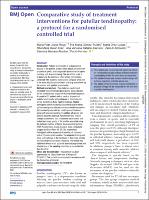Por favor, use este identificador para citar o enlazar este ítem:
https://repositorio.usj.es/handle/123456789/524
Registro completo de metadatos
| Campo DC | Valor | Lengua/Idioma |
|---|---|---|
| dc.contributor.author | López-Royo, María Pilar | - |
| dc.contributor.author | Gómez-Trullén, Eva María | - |
| dc.contributor.author | Ortiz Lucas, María | - |
| dc.contributor.author | Galán-Díaz, Rita María | - |
| dc.contributor.author | Bataller-Cervero, Ana Vanessa | - |
| dc.contributor.author | Al-Boloushi, Zaid | - |
| dc.contributor.author | Hamam Alcober, Yasmina | - |
| dc.contributor.author | Herrero Gállego, Pablo | - |
| dc.date.accessioned | 2021-03-17T10:43:17Z | - |
| dc.date.available | 2021-03-17T10:43:17Z | - |
| dc.date.issued | 2020-01-23 | - |
| dc.identifier.citation | López-Royo MP, Gómez-Trullén EM, Ortiz-Lucas M,et al. Comparative study of treatment interventions for patellar tendinopathy: a protocol for a randomised controlled trial. BMJ Open2020;10:e034304. doi:10.1136/bmjopen-2019-034304 | es_ES |
| dc.identifier.issn | 2044-6055 | es_ES |
| dc.identifier.uri | https://repositorio.usj.es/handle/123456789/524 | - |
| dc.description.abstract | IntroductionPatellar tendinopathy is a degenerative disease of the patellar tendon, which affects athletes from a variety of sports, and is especially predominant in sports involving high-impact jumping. The aim of this study is to determine the additional effect of two interventions combined with eccentric exercise and compare which one is the most effective at short-term and long-term follow-up for patients with patellar tendinopathy.Methods and analysisThis study is a randomised controlled trial with blinded participants. Measurements will be carried out by a specially trained blinded assessor. A sample of 57 patients with a medical diagnosis of patellar tendinopathy will participate in this study and will be divided into three treatment groups. Eligible participants will be randomly allocated to receive either: (a) treatment group with percutaneous needle electrolysis, (b) treatment group with dry needling or (c) treatment group with placebo needling. In addition, all groups will perform eccentric exercise. Functionality and muscle strength parameters, pain, ultrasound appearances and patient perceived quality of life shall be evaluated using the Victorian Institute of Sports Assessment for patellar (VISA-P), jump tests, Visual Analogue Scale, ultrasound images and Short Form-36 (SF-36), respectively. Participants will be assessed at baseline, at 10 weeks and at 22 weeks after baseline. The expected findings will allow us to advance in the treatment of this injury, as they will help determine whether a needling intervention has additional effects on an eccentric exercise programme and whether any of the needling modalities is more effective than the other | es_ES |
| dc.format.extent | 8 p. | es_ES |
| dc.format.mimetype | application/pdf | es_ES |
| dc.language.iso | eng | es_ES |
| dc.publisher | BMJ PUBLISHING GROUP | es_ES |
| dc.rights | Atribución-NoComercial 4.0 Internacional | * |
| dc.rights.uri | http://creativecommons.org/licenses/by-nc/4.0/ | * |
| dc.subject | Platelet-rich plasma | es_ES |
| dc.subject | Jumpers knee | es_ES |
| dc.subject | Eccentric exercise | es_ES |
| dc.subject | Different sports | es_ES |
| dc.subject | Tendón | es_ES |
| dc.subject | Reliability | es_ES |
| dc.subject | Prevalence | es_ES |
| dc.subject | Validity | es_ES |
| dc.subject | Squat | es_ES |
| dc.title | Comparative study of treatment interventions for patellar tendinopathy: a protocol for a randomised controlled trial | es_ES |
| dc.type | info:eu-repo/semantics/article | es_ES |
| dc.identifier.doi | 10.1136/bmjopen-2019-034304 | es_ES |
| dc.rights.accessrights | info:eu-repo/semantics/openAccess | es_ES |
| Aparece en las colecciones: | Artículos de revistas | |
Ficheros en este ítem:
| Fichero | Descripción | Tamaño | Formato | |
|---|---|---|---|---|
| Comparative study of treatment interventions for patellar tendinopathy.pdf | 434,28 kB | Adobe PDF |  Visualizar/Abrir |
Este ítem está sujeto a una licencia Creative Commons Licencia Creative Commons

